Issue: 73 Page: 50
Saving Wild Ginseng, Goldenseal, and other Native Plants from Mountain Top Removal
by Dean Myles
HerbalGram. 2007; 73:50 American Botanical Council
The Appalachian Mountains are renowned for their pristine hardwood forest, valuable low sulfur coal, and rugged way of life. For centuries, Appalachia has also had the reputation of being the ideal habitat of two economically significant medicinal plant species—wild American ginseng (Panax quinquefolius L., Araliaceae) and goldenseal (Hydrastis canadensis L., Ranunculaceae). Appalachian families have created a time-honored tradition out of harvesting these and many other medicinal plants for alternative income and medicine. Appalachian forests have been and continue to be a major source for herbs used in folkloric herbal remedies and phytomedicines.1
In recent years, the popularity of herbal medicines, both domestically and in foreign markets, has led to concerns on the part of wildlife biologists and other experts about the possible over-harvest of wild American ginseng and goldenseal, and about their future sustainability as wild-harvested secondary forest products. Unsustainable harvesting, coupled with habitat destruction from mining, timbering, and other industrial activities, as well as browsing by deer and other herbivores, is escalating the demise of many significant woodland species. It is estimated that more than 400,000 acres of rich Appalachian forest have been turned into infertile grasslands, with another 230,000 acres designated for the same fate.2,3 To protect wild ginseng from possible extinction, the West Virginia (WV) legislature has implemented new regulations concerning harvesting. The new law has delayed the harvesting season by two weeks, allowing significant time for the berries to fully ripen.4 The new regulations also address the concerns of unlawful collection (poaching), planting ginseng on public land, cultivating ginseng on private land, and the introduction of exotic germplasm. However, neither the West Virginia legislature nor the federal government has dealt with the issue of habitat loss for ginseng and several other medicinal plants of value as a result of practices by the coal mining industry. It is illegal to dig ginseng out of season for any purpose, including its rescue from destruction, without the proper documentation.4 Yet, the mining industry is currently permitted to completely and methodically obliterate ginseng and its entire habitat in the name of economic activity.
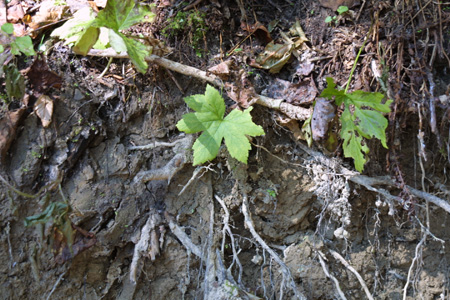
Figure 1. Goldenseal (Hydrastis canadensis) plant struggling to survive. Photo © Dean Myles 2004
In the past coal has been the primary means of generating revenue for the citizens of West Virginia, but that income has come at a steep price. Many miners have lost their lives, and the ones who survived a career in the mines have often developed black lung disease (silicosis) or some other type of physical impairment. Today, tourism is playing an increasingly important economic role, generating $34 billon to West Virginia yearly.5 Tourism also supports 41,000 jobs and adds $536 million to tax revenues collected. The rivers and mountains of West Virginia attract individuals from all over the world to experience first class white-water rapids and to hike and bike the rugged mountains. Meanwhile, due to the overwhelming demand for energy, the culture and landscape of Central Appalachia is being forever changed by the destruction of the very asset that makes this region so attractive—mountains.
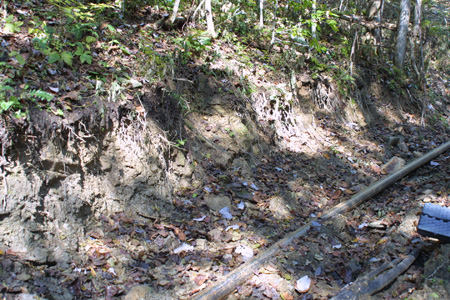
Figure 2. Goldenseal (Hydrastis canadensis) population destroyed by gas line construction in southern West Virginia. Photo © Dean Myles 2004
I became aware of the seriousness of habitat destruction while serving as an intern with the Medicinal Botanicals Program (MBP) at Mountain State University (MSU) in Beckley, WV, during the 2003-2004 academic year. My assignment was to investigate goldenseal populations in Southern West Virginia. While conducting a literature review on goldenseal, I obtained a paper by James McGraw, professor of biology at West Virginia University, addressing the distribution of wild ginseng and goldenseal in central Appalachia. McGraw investigated 16 sites in West Virginia, Pennsylvania, Kentucky, Ohio, and Maryland, covering a total of 26 hectares. His investigation concluded that so few goldenseal patches were found that his team was unable to detect statistically significant effects of elevation, aspect, or vegetation on goldenseal’s encounter probability.6 (Encounter probability is a scientific/mathematical formula for determining the probability of encountering a specific plant or animal species while walking in a certain prescribed area of land.) McGraw’s report asserts that goldenseal was “limited” in the region. While investigating native goldenseal populations in the southern part of the state, I learned about the destruction of entire forests and goldenseal populations by the mining and timber industries. I have witnessed firsthand how fast plant populations and entire ecosystems can be destroyed. A native goldenseal population that I observed in a healthy forest in August 2003 was completely decimated by March 2004. The remaining forest is now a desolate mountain stripped of its trees and wildlife for a coal mining operation. This mountaintop and the surrounding area was once the habitat of not only goldenseal but other important medicinal plants such as wild ginseng, spikenard (Aralia racemosa L., Araliaceae), bethroot (Trillium erectum L., Liliaceae), lady’s slipper (Cypripedium pubescens Willd, Orchidaceae), and Jack-in-the-pulpit (Arisaema triphyllum L. Araceae). A second goldenseal population located during my initial investigation has also fallen victim to the energy resource extraction industry. This goldenseal population was destroyed by the construction of a gas line (see Figures 1 and 2). The site was also inhabited by various woodland species including the ones mentioned above at the previous site. This gas line was placed without regard to the plant life in the area. If the gas line would have been placed about 20 feet farther up or down the slope, it would have missed the goldenseal population. Gas line placement and the location of logging roads and skidder trails (trails left by logs dragged out of the woods) are habitually laid without regard to the plant communities. Timbering modifies the available sunlight in the forest and temperature regime, and it can be a factor in the demise of some species of both plants and animals. Even though the forest can rejuvenate itself eventually, rare and indigenous plant populations may not recover from road placement, logging, mining, and other human activity. Mountain Top Removal (MTR) Destruction of habitat is nothing new to West Virginia and the Appalachian Mountains, but with the advent of new earthmoving technology, the disturbance is far greater. Surface mining became popular in Appalachia after the Second World War, and the issue of environmental degradation soon began.7 Today, the major threat to the local plant environment centers around a new type of surface mining operation called mountain top removal (MTR). Unfortunately, MTR is turning the most biologically diverse region in the United States into barren grasslands. The MTR process begins by removing the salable timber from the selected area. Because this is not a registered timber operation, the Forest Service rules for timber extractions do not apply to mining activity, so there is no buffer zone for intermittent stream beds. Also, skidder trails are not designed to control water run-off, resulting in the pollution of debris into local streams. Once the timber is extracted, the drilling process begins. Holes are drilled and then filled with explosives that blast away hundreds of cubic feet of rock and forest soil. This allows the removal of what is in most cases a shallow coal seam. The MTR process reduces the elevation of the former mountain top by as much as 20%.7
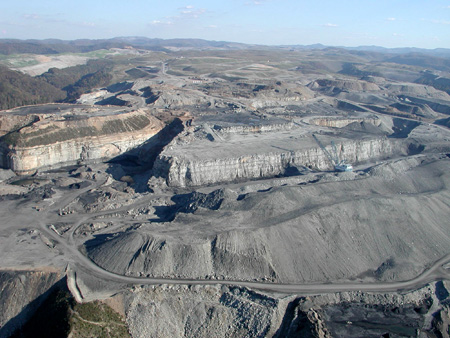
Figure 3. View of Kayford Mountain site, West Virginia, on October 19, 2003. This is becoming a familiar scene in Appalachian coal country with over 380,000 acres of rugged mountains being altered into level, grassy plateaus by mountain top removal operations. Photo © Vivian Stockmen www.ohvec.org.

Figure 4. View of Kayford Mountain site, West Virginia, on June 15, 2005. This mountain top removal (MTR) site comprises nearly 10,000 acres of land and is located less than 30 miles from Beckley, West Virginia. Note the expansion of the MTR site compared to Figure 3. Photo © Vivian Stockmen/www.ohvec.org.
Data from the Institute for Makers of Explosives shows that 67% of the 2.52 million metric tons (Mt) of explosives produced in the United States in 2004 were used by the mining industry.8 In 2004, mining operations used 946,300 Mt of explosives in West Virginia, Kentucky, Virginia, Pennsylvania, and Tennessee. (States are listed in descending order according to the amount of explosives used.) Ninety-eight percent of the blasting agents used in mining are ammonium-nitrate based.8 For comparison, the Oklahoma City bombing in 1995 used 1.8 Mt. (4000 lbs) of ammonium-nitrate.9 This means it would take approximately 1140 Oklahoma City bombs to equal the amount of explosives unleashed every day in central Appalachia. Once the over-burden (debris) is loosened and removed to expose the coal seam, the debris is dumped in the valleys lying between the ridge tops, creating “valley fills.” These valley fills destroy areas rich in biodiversity. This loss of biodiversity can never be replaced. Not only does MTR impact the immediate habitat, it also affects the entire ecological and hydrological system. MTR mining processes are responsible for increasing the amounts of metals, sulfates, and dissolved and suspended solids in streams and ground water.10 From 1992 to 2002, MTR has been responsible for the destruction of 1,208 miles of streams and the deforestation of 380,574 acres of pristine forest in the Appalachian region.2 If current trends continue, a projected loss of 1.4 million acres of Appalachian forest will be lost by the end of the next decade.3 The reclamation practices carried out by MTR and other strip mining operations cannot restore the rich biologically diverse forest that make Appalachia unique. The process of strip mining completely destroys the nutrient-holding topsoil of the affected area. As a “soil substitute” for the original topsoil, strip mining reclamation practices employ material made from brown sandstone to hold plant species selected for hydro-seeding.10 Another dilemma is the use of non-native grasses such as legumes and other species for reclamation. A 2003 Rutgers University technical study on MTR and valley fills suggests relatively low numbers of woody species were present in mined areas compared to intact forests.11 The study also reports that the native woody species that do manage to invade mine sites are very close to the remaining forest edge and are less than 2.54 cm in diameter at the base. The combination of poor substrate quality and interference by inappropriate grass cover restricts the ability of native plant communities to return to these extensive grasslands. The study concludes that the presence and composition of the forest herb stratum is critical for forest health, as the herbs maintain soil structure, add nutrients, and offer habitat and forage to many animal species. The report also suggests that herbaceous woodland species will not reestablish in mining areas due to loss of critical micro-habitat provided by the intact forest canopy. The Office of Surface Mining’s goal is to reclaim areas to a green and stable environment, but it does not reclaim the ecology or land use capability as required by law (see Figures 3 and 4). Between 1980 and 1999, 200,000 acres of land were permitted for MTR in West Virginia.12 As of 1999 there were 11,500 permitted valley fills encompassing another 100,000 acres in the region. The majority of the mining activity occurs in the mountainous regions of southern West Virginia and eastern Kentucky. MTR occurs in 60% of the watersheds within this region. This also happens to be primary habitat for wild ginseng and goldenseal. The harvesting records for ginseng in West Virginia show a definite decline in harvest amounts (see Figure 5 on page 54). The harvesting record is broken down by county. Ginseng is harvested from each of the 55 counties, but the southern counties have historically been the major wild ginseng producers. Over a 28-year period, the 7 highest ginseng-producing counties in West Virginia are Wyoming (34,166 lbs.), McDowell (32,167 lbs.), Logan (31,769 lbs.), Mingo (27,281 lbs.), Boone (25,638 lbs.), Raleigh (24,672 lbs.), and Kanawha (22,458 lbs.). Collectively, these counties have produced over 202,000 lbs. of wild ginseng. These same counties are now undergoing extensive MTR operations, with Boone, Logan, and Mingo counties being the top producers of surfaced coal tonnage.13 McGraw reports that decreased harvests of wild ginseng also correlate with unemployment in Appalachia.14 In 1980 the unemployment rate was 9.6%, up from 6.9% the previous year.15 In 1983 unemployment was 17.4% and in 1984 it was 14.7%. During this period, West Virginia experienced the highest unemployment rate in its history. In 1997, the MTR removal process became the preferred coal extraction process in the southern counties.14 As MTR increases across the southern West Virginia coal fields, the wild ginseng harvesting rate decreases. Despite the increase in coal mining operations, the number of employed miners has decreases. In 1984, during the peak harvesting, 39,950 coal miners were employed in the state.16 In 1997 when the decline in harvesting became evident, only 18,165 coal miners were employed in the state. Today fewer than 15,000 are working in West Virginia. Conservation of Appalachian Medicinal Plants (CAMP) In response to this loss of native woodland flora, I initiated the Conservation of Appalachian Medicinal Plants (CAMP) to rescue plants of medicinal and ornamental value from destructive industrial activity (see Table 1). Rescued plants are relocated to areas where they will be used for education and research. Since the fall of 2004, CAMP has been involved with locating and rescuing plants from a 4000-acre property in the Coal River Basin that was scheduled to become a MTR operation. More than 15 medicinal species, including ginseng and goldenseal, have been documented and moved to safe locations.
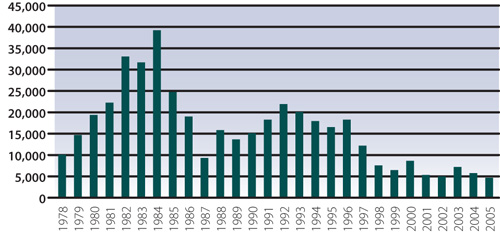
Figure 5. West Virginia Ginseng Harvest 1978–2005: A 28 Year History. Source: West Virginia Division of Forestry.
Rescued plants have been placed in the new Medicinal Botanicals Garden and Walking Trail at Mountain State University (MSU). The Medicinal Botanicals Program (MBP) at MSU is working with other organizations to educate and develop similar trails in the area. In addition, plants have been placed in research plots to evaluate how the environment may affect medicinal chemical constituents. Studies are also being conducted on growth rates, yields, and chemical diversity among native medicinal plant populations. As of fall 2005, 26 native goldenseal populations in 5 southern West Virginia counties have been located and characterized in an effort to select elite germplasm for the medicinal market. Efforts are being made to communicate with local coal company owners to allow sufficient time for rescue operations by CAMP and other organizations and to persuade mining companies to conduct their own salvage operations for reestablishment of remnant forests surrounding their valley fills. The MBP is continuing work to promote the establishment of the herbal industry in Appalachia. With the collaboration of educators, researchers, environmental groups and concerned citizens, MPB is dedicated to preserving the rich heritage of biodiversity for future generations of Appalachian children.
Dean Myles is a native of Southern West Virginia. Dean graduated Magna Cum Laude from Mountain State University in Beckley, WV, with a Bachelors of Science degree in Ecology in 2004. He is currently working to complete a Masters Degree in Plant Science and is the Coordinator of the Medicinal Botanicals Program at MSU. He can be contacted via e-mail at dmyles@mountainstate.edu.
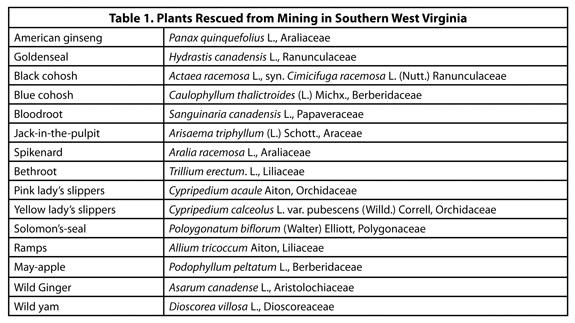
References 1. Duke JA. Phytomedicinal forest harvest in the United States. Medicinal Plants for forest conservation and healthcare. Non-wood forest products 11 [online]. Food and Agriculture Organization of the United Nations; 1998. Available at http://www.fao.org/docrep/w7261e/w7261e17.htm. 2. Ward K Jr. Mountaintop removal could devastate region. The Charleston Gazette [online]. May 5, 2002. Available at: http://wvgazette.com/static/series/mining/. Accessed August 7, 2006. 3. Leveling a Mountain of Research on Mountaintop Removal Mining. Scientific Integrity in Policymaking. Cambridge, MA: Union of Concerned Scientists; July 2004:7. Available at: http://www.ucsusa.org/assets/documents/scientific_integrity/Scientific_Integrity_in_Policy_Making_July_2004_1.pdf. 4. WV Ginseng Regulations. Title 22 Legislative Rule. West Virginia Division of Forestry. 2005. Available at: http://www.wvforestry.org. 5. Gresham C. Gov. Manchin tours West Virginia vacation destinations for TV news features. WV Tourism News Release. South Charleston, WV: West Virginia Division of Tourism. June 5, 2006. Available at: http://www.callwvanews.com/releases/newsreleases/nr060605.htm. 6. McGraw JB, Sanders S, Van der Voort, M. Distribution and abundance of Hydrastis canadensis L (Ranunculaceae) and Panax quinquefolius L. (Araliaceae) in the central Appalachian region. Journal of the Torrey Botanical Society. 2003;130:62-69. 7. Montrie C. To Save the Land and People: A History of Opposition to Surface Coal Mining in Appalachia. Chapel Hill, NC: University of North Carolina Press; 2003. 8. Kramer D. Explosives. US Geological Survey. 2004. Available at: http://www.usgs.gov/. 9. Thomas J. New challenges to prosecution in bomb trial. New York Times. December 11, 1997:16. 10. Mountaintop Mining/Valley Fills in Appalachia: Final Programmatic Environmental Impact Statement. Washington, DC: US Environmental Protection Agency; 2005. Available at: http://www.epa.gov/region3/mtntop/index.htm. 11. Handel SN. Mountaintop Removal Mining/Valley Fill Environmental Impact Statement Technical Study Project Report for Terrestrial Studies: Terrestrial Plant (spring herbs, woody plants) Populations of Forested and Reclaimed Sites. Dept. of Ecology, Evolution, and Natural Resources. Newark NJ: Rutgers University; 2003. 12. Claggett P, Pomponio J, Clifton E. A Landscape-scale Approach for Evaluating Cumulative Impacts Preliminary Study Results. Valley Forge, PA: Canaan Valley Institute; 2000. Available at: http://gis.esri.com/library/userconf/proc00/professional/indices/track_a6.htm. 13. Fedorko N, Blake M. A Geological Overview of Mountaintop Removal Mining in West Virginia. West Virginia Geological and Economic Survey; 1998. Available at: http://www.wvgs.wvnet.edu/www/mtrm/wvgesmtr.pdf. 14. Ford P. Annex 1 American Ginseng (Panax quinquefolius L.): Species Review. Washington DC: US Fish and Wildlife Service; 2005. Available at: http://www.fws.gov/international/pdf/Annex1GinsengSpeciesReview.pdf. 15. West Virginia Labor Force Statistics 1978-2005. Work Force West Virginia, Department of Commerce; 2006. Available at: http://www.wvbep.org/bep/lmi/DATAREL/Drsad&w.htm. Accessed August 7, 2006. 16. Coal Facts. Charleston, WV: West Virginia Coal Association; 2004. Available at: http://www.wvcoal.com/.
|